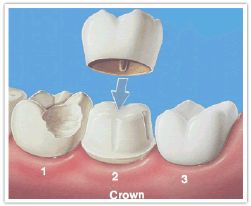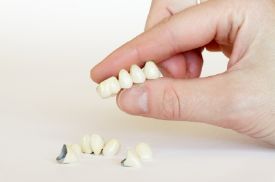
What is a crown/ cap?
This is a covering placed over the existing natural tooth or what’s left of it to bring it back to its original size and shape. It is normally done when:
- A tooth is so bad that it cannot be restored using the normal filling materials.
- When a large filling is very discoloured and you want to improve its appearance
- A tooth which is root canal treated and needs to be protected from fracture.
- Following an accidental damage to your tooth
- To hold a bridge or a denture in place.
- When a tooth is discoloured and cannot be whitened using normal whitening procedures.
There are different types of materials for crowns, such as plastic (acrylic), composite, porcelain fused to metal, full metal, or full porcelain ( Procera/ zirconium). These last are being more widely used today because of their more natural looking appearance. They match the colour of your natural teeth to a high degree and give the crowns a greater translucency, and hence a more natural look. Porcelain fused to metal crowns have a very high strength and are still widely used, and can give very good results also. The other types of materials are less commonly used although they are lower in price, and this is their main attraction. However they do give also a very natural appearance to the tooth. Plastic is liable to fracture in use because it tends to wear down with time.
Procedure for making caps:
If the tooth still has a nerve, then a local anaesthetic is given. If the tooth is root treated than no anaesthetic is normally required. The dentist prepares the tooth to the required shape and size, leaving a core onto which the crown then seats. The amount of tooth removed with the drill is roughly eqivalent to the thickness of the future crown. Once this part of the procedure is ready the dentist takes a shape of the tooth using silicone materials and also a shape of the opposing jaw. These impressions/ shapes are then sent to the laboratory where a technician will proceed to fabricate the crown from these measurements. The patient will usually have to pay a visit to the laboratory for the technician to match the shade of the crown to the patients’ natural teeth.
The lab usually takes around 1 to 2 weeks to prepare the crown. In the mean time the dentist will fit on a temporary plastic crown till the next appointment.
When a tooth is root treated and is to be capped/ crowned, a fibre post is usually inserted into one of the roots to make the core stronger and give better retention to the crown. Fibre posts are more widely used nowadays because of their greater flexibility. The use of stainless steel and gold posts is on the decline because they tend to cause fractures of the root with time.
Once the crown is back from the lab, the dentist tries on the crown on the core for fit , shape and shade. If all is ok and the patient is happy, the dentist cements the crown on using appropriate dental cements.
Many patients ask how long the crown will last for. This will depend on how well you look after the crown and keep it clean, especially around the area where the edge of the crown meets the tooth underneath it. If this area is kept very clean the crown will last for many many years. It is important to maintain 6 monthly check ups and if necessary to have a scale and polish done also.




